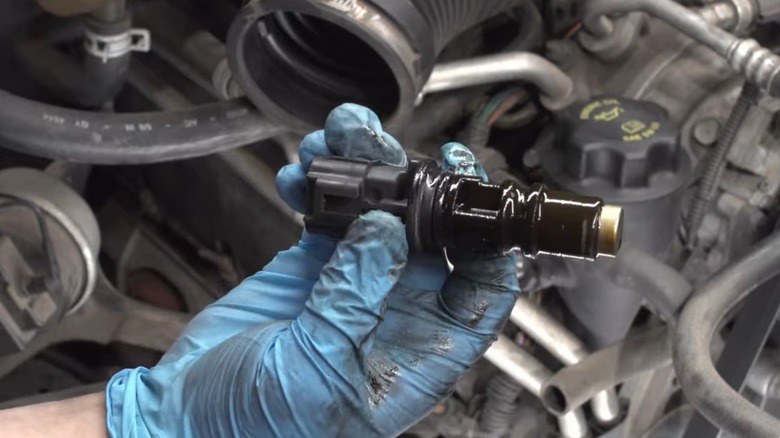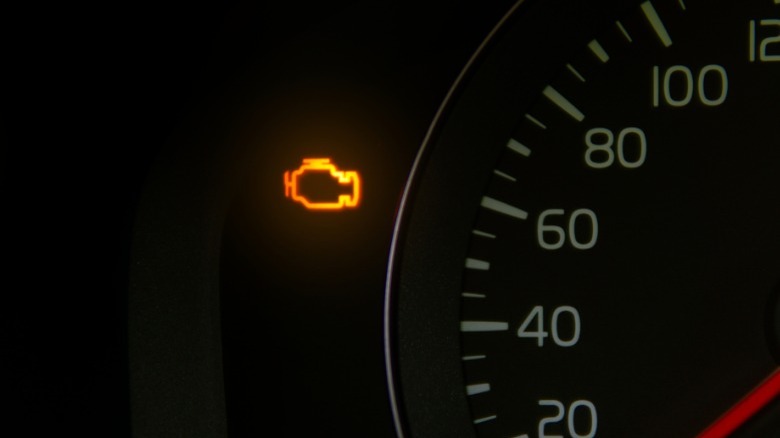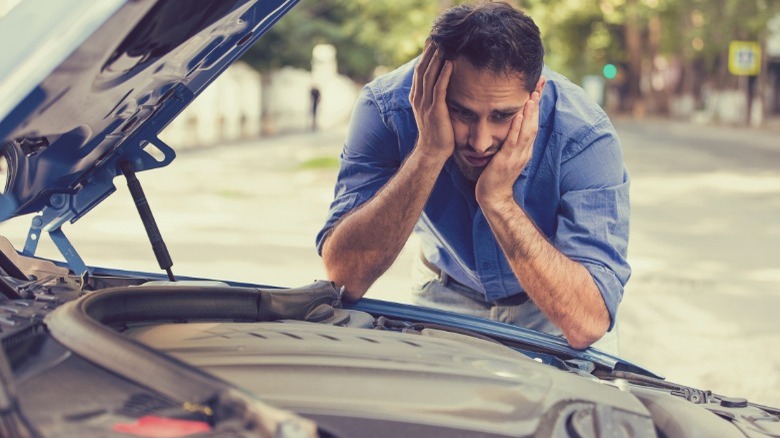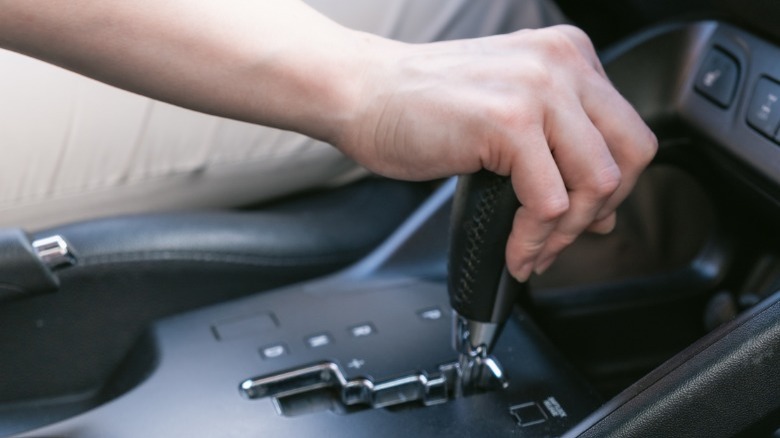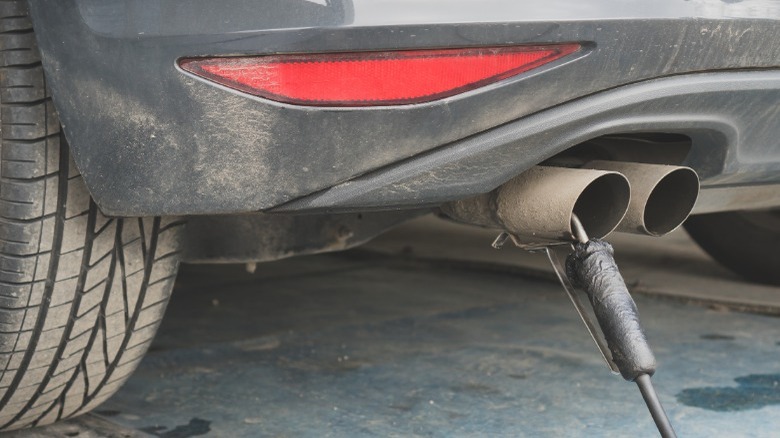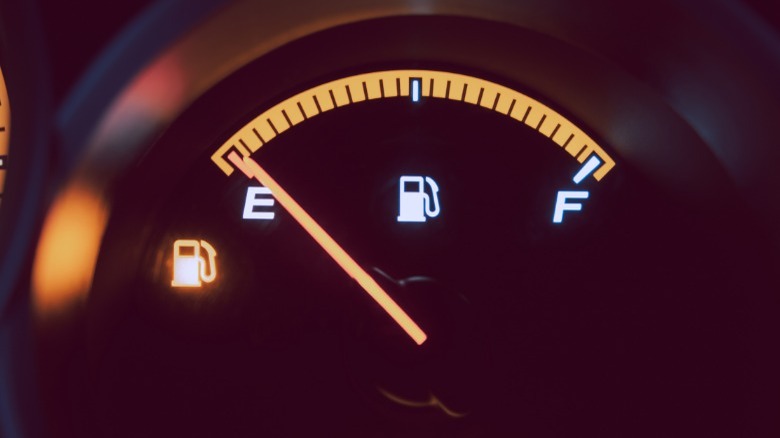6 Signs Your Engine's Camshaft Position Sensor Is Failing
Your car's camshaft — or camshafts if your vehicle has a DOHC engine — is a vital component that plays a critical role in the internal combustion process. Its job is to synchronize the opening and closing of the exhaust and intake valves with the movement of the engine's pistons, and it works hand-in-hand with the crankshaft, which is a distinct component, even if the names sound similar. Although the camshaft(s) and crankshaft work together to keep your motor firing and your wheels moving, they rely on more than just each other to accomplish these feats.
Like many other automotive components, the camshaft(s) works with various parts and systems to keep your vehicle running smoothly. One of those parts is the camshaft position sensor. As the name implies, the sensor monitors the camshaft's position and movement, and it sends that data to the car's computer or electronic control unit (ECU). The ECU uses that information to regulate and control things like engine ignition timing, fuel injection, and more. If the sensor fails or malfunctions, it can cause some pretty annoying issues for your car.
Unfortunately, the symptoms of a failing camshaft position sensor are very similar to the signs that another related sensor — the crankshaft position sensor — is bad, which can make diagnosis tricky. As a former auto repair technician and a lifelong car nerd, I'll break down the most common signs of a faulty camshaft position sensor. We'll explore these symptoms together, and I'll explain a few ways that you may be able to differentiate between a bad camshaft position sensor and a bad crankshaft position sensor. That said, you may still need professional help to diagnose the problem definitively. For now, here are six signs that your engine's camshaft position sensor is failing.
Your check engine light is on
One of the primary symptoms of a failing camshaft position sensor is an illuminated check engine light. The check engine light is one of your car's many dashboard warning lights. It's designed to appear when the vehicle's computer detects a problem with one of the many components or systems that power your car. The tricky part is that various problems can cause the check engine light to appear on your dash, including a faulty camshaft position sensor.
As mentioned, the ECU relies on the camshaft position sensor to send dependable and accurate information, and the computer then uses that data to control various critical vehicle systems. However, if the sensor stops sending data or begins sending inaccurate or erratic data, the ECU will be unable to perform its job properly and will detect an error with the sensor's operation. That error may trigger your car's onboard diagnostic system, activating the dashboard warning light and storing a diagnostic trouble code (DTC) inside the computer. You'll need an OBDII scan tool to read those DTCs in most cases. However, depending on your vehicle's age and its make and model, you may be able to identify your DTCs without a code reader.
The car is hard to start
Another common sign of a bad camshaft position sensor is difficulty starting your engine. We mentioned that the camshaft position sensor is responsible for relaying vital information to the car's computer, and that the computer then uses that data to control things like ignition timing and fuel injection. Well, fuel injection and ignition timing both play key roles in the process of starting your engine. The fuel injection system contains parts like the fuel injectors, fuel pump, and fuel pressure regulator, and it's responsible for metering exact amounts of fuel into the combustion chambers. The ignition timing system, on the other hand, features components like the spark plugs, coil packs, and, depending on your vehicle, a distributor. It's responsible for igniting the mixture of fuel and air inside the combustion chambers, creating the tiny explosions that power your car.
If the timing is off by even a second, or if the incorrect amounts of fuel reach the combustion chambers, your car's motor will have a substantially harder time turning over, and it may refuse to start at all if the situation is bad enough. The problem occurs when the camshaft position sensor stops sending data or starts sending inaccurate information to the ECU. However, it's worth keeping in mind that various problems can result in a car that won't start. If you're having trouble cranking your engine, and you suspect a faulty camshaft position sensor, you should visit a professional mechanic for an inspection.
Poor engine performance
If your camshaft position sensor is failing, you'll most likely experience poor engine performance. This symptom can be a bit trickier to nail down, though, due to the various different problems it can entail. That's because "poor engine performance" is essentially an umbrella term, covering various car problems like decreased acceleration, misfires, a rough idle, and engine stalling. To make things even more confusing, there are several conditions and malfunctions that can cause poor engine performance, including a bad or failing camshaft position sensor.
In the case of a bad camshaft position sensor, this issue occurs because the ECU is getting incorrect or erratic data or no data at all from the sensor. When that happens, the computer will be unable to properly regulate and control things like the engine RPM, the fuel injection, and the ignition timing. The ECU's inability to perform its job properly will lead to various problems for your car, and often, those problems will take the form of performance issues, like rough or inconsistent idling, reduced power and acceleration, and sudden stalling. Again, a lot of different mechanical problems can cause performance issues. If your car's engine begins performing poorly, you should monitor the issue to identify any other symptoms that may help you pinpoint the root cause and prioritize visiting a mechanic for inspection and repair.
The transmission starts acting up
One of the more surprising symptoms that you may experience if you have a bad or failing camshaft position sensor is transmission trouble. The issue may present itself as hard shifting, delayed shifts, or a failure to go into gear, and some vehicles may even enter a reduced engine power mode or limp mode. When this occurs, your car's computer will attempt to protect the engine from further damage by restricting power and speed, and you'll struggle to move your vehicle down the road.
A lot of different issues can cause transmission problems, and many of those issues are more directly related to the transmission than the camshaft position sensor, making the ultimate source of the problem difficult to identify. If you do experience this issue, there are a couple of steps you can take to help identify or, at the very least, narrow down the source of the problem to a few potential culprits. The first thing you should know is that transmission trouble is one symptom of a failing camshaft position sensor that you're less likely to encounter if your crankshaft position sensor is bad.
Remember how we said that both sensors can produce many of the same symptoms when they go bad? If your car has transmission issues and any of the other symptoms described above, there's a good chance the camshaft position sensor is to blame — although there will always be exceptions. Next, you should check a few basic things to rule out common transmission problems. Inspect your transmission fluid to determine if it's within the appropriate range and whether it's clean and in good condition. Doing so can help you rule out simpler issues and help your mechanic diagnose the root problem more quickly.
You fail an emissions test
Another sign that your camshaft position sensor is bad or failing is a failed emissions test. Currently, at least 29 states require emissions tests before you can register your vehicle or renew your existing registration. Several other states require some form of emissions testing in various areas, without making the test mandatory statewide. That means that more than half the country requires some form of smog testing, and if a faulty camshaft position sensor prevents you from passing, you may find yourself stranded without a reliable means of transportation.
You're likely to experience this problem if you have a bad camshaft position sensor because the disruption in data sent to the ECU can cause the fuel system malfunction. When that occurs, your engine may begin burning fuel inefficiently or sending large amounts of unburnt fuel back into the atmosphere — your car may even develop a strong gas odor if the problem gets bad enough. Neither option is good for your car or the environment, and erratic or wasteful fuel usage will almost always cause you to fail your emissions test.
The tricky part is that various issues can cause your vehicle to fail its smog test. It's not always easy to identify the source of an emissions problem, and technicians must often spend a lot of time with the car to diagnose and fix the issue. If your vehicle fails its annual emissions test, you should prioritize fixing the problem as soon as possible. Doing so can help prevent even greater and more expensive damage and contribute to cleaner air for us all to breathe.
Your fuel economy plummets
If your camshaft position sensor is sending inaccurate or inconsistent data to the ECU, or if it stops sending data altogether, you're very likely to notice a drop in your car's fuel economy. That means spending more time filling up at the pump and spending increasing amounts of money on fuel. It can also result in unanticipated breakdowns if you fail to pay attention to your fuel gauge and are used to going longer in between trips to the gas station.
We've mentioned a few times that the camshaft position sensor sends key data about the camshaft(s) movement and position to the car's ECU. We've also covered the ways that the ECU uses that data to control critical systems and functions like the ignition timing, fuel injection, and engine RPM. Well, when the sensor stops sending data or starts sending incorrect data, the ECU will be unable to regulate the fuel injection system properly. That can lead to disruptions in the fuel system and the combustion process, as incorrect camshaft position sensor data can cause the ECU to send the incorrect amounts of fuel to the injectors.
When that occurs, your gas mileage may drop. You'll also probably notice a drop in fuel mileage due to the various other issues that a faulty camshaft position sensor can cause. If the engine has to work harder to overcome these problems, it's going to use a lot more fuel to make up for that extra work. However, it's worth noting that various problems can cause your car's gas mileage to plummet. If you encounter this problem or any of the other issues discussed here, you should reach out to a professional mechanic as soon as possible.
